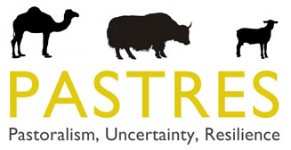
This section contains three shorter lectures, which aim to provide some basic background on livestock systems from a technical standpoint.
Pastoralism is the finely-honed symbiotic relationship between local ecology, domesticated livestock and people in resource-limited and highly-variable regions, where other forms of agricultural production are less effective. Livestock are the vital ‘technologies’ that allows transforming variable range vegetation into different products, including food. However, the system can be altered by adding in new fodder sources (reinforcing rangelands, cultivating or importing fodder) and can shift through the impact of disease, each affecting patterns of production (weight gain, milk production, birth rates, death rates etc).
 Questions
Questions
In a pastoral system that you know:
- What are the major livestock species, and their production characteristics? What production constraints are faced, and how do pastoralists deal with these?
- What type of fodder/feed system dominates, what are the feed limitations in terms of quantity and quality? What systems of grazing/fodder management/supplementation are used?
- What are the major livestock diseases, and how do they affect different animals? Are these epidemic (outbreaks) or endemic (continuous) diseases?
Part 1: Livestock production
In this lecture, Michele Nori offers a basic introduction to various livestock species – sheep, cattle, goats, camels and yak. Animal physiology (climate resilience, fertility, feed requirements, rumination, etc) and performance (reproductive rates, milk productivity, etc) for the different species are discussed, together with their role and relevance for pastoral livelihoods (milk economy, herd/flock diversification, complementarities).
 Watch the lecture
Watch the lecture
 Readings
Readings
- Dahl, G. and Hjort, A. (1976) Having Herds: Pastoral Herd Growth and Household Economy. Stockholm: Stockholm Studies in Social Anthropology.
- Hoegel, U. et al. (2015) Sustainable Livestock Production? Industrial Agriculture versus Pastoralism. CDE Policy Brief. Bern: CDE.
Some online resources:
- Yak International Conferences – proceedings of international conferences
- ISOCARD International Camel Society – proceedings of international conferences
- CIHEAM FAO network on small ruminants – proceedings of international conferences
Part 2: Pasture production and fodder
Key features of livestock feed resources are introduced in this lecture by Antonello Franca. The case of Sardinia is used to show patterns and dynamics that are indicative of the Mediterranean region, and of pastoral areas more generally.
The lecture specifically focuses on:
- The dynamics of the last century: from agro-pastoral to agro-silvopastoral resources, and the transition towards a more diversified land use for semi-extensive grazing.
- Livestock and fodder availability: grass components, woody and shrubs components, and the different feeding behaviour of grazing animals.
- Forage management practices: a rapid overview on the main agronomy practices utilized for improving pasture quality and availability in marginal areas.
 Watch the lecture
Watch the lecture
 Readings
Readings
- Porqueddu C, Melis RAM, Franca A, Sanna F, Hadjigeorgiou I, Casasús I (2017) The role of grasslands in the less favoured areas of Mediterranean Europe. Grassl. Sci. Eur. 22:3–22
- Porqueddu C., Ates S., Louhaichi M., Kyriazopoulos A. P., Moreno G., del Pozo A., Ovalle C., Ewing M. A. and Nichols P.G.H. (2016) Grasslands in ‘Old World’ and ‘New World’ Mediterranean-climate zones: past trends, current status and future research priorities. Grass and Forage Science 71: 1-35.
- Caballero, R., Fernadez-Gonzalez, F., Molle, G., Roggero, P.P., Bagella, S., D’Ottavio, P., Papanastasis, V.P., Fotidias, G., Sidiropoulou, A., Ispikoudis, I. (2009) Grazing systems and biodiversity in Mediterranean areas: Spain, Italy and Greece. Pastos XXXIX: 154
- Furesi, R., Madau, F.A., Pulina, P. (2013) Technical efficiency in the sheep dairy industry: an application on the Sardinian (Italy) sector. Agricultural and Food Economics, 1:4
Part 3: Livestock diseases
In this short lecture, Alex Tasker identifies the key features of livestock diseases in pastoralist populations. Starting with an overview of livestock disease transmission routes (vectors) between the environment, other animals, and humans (zoonoses), he discusses how disease and infection can impact health and production in pastoralist populations.
Having identified the potential importance of livestock disease for pastoralist resilience research, Dr Tasker highlights examples of disease detection, diagnosis, and treatment systems that you may encounter in your work.
 Watch the lecture
Watch the lecture
 Readings
Readings
- Bett, B., Jost, C., Allport, R. and Mariner, J. (2009) Using participatory epidemiological techniques to estimate the relative incidence and impact on livelihoods of livestock diseases amongst nomadic pastoralists in Turkana South District, Kenya. Preventive Veterinary Medicine, 90(3-4): 194-203.
- Catley A., Leyland T., Mariner J., Akabwai D., Admassu B., Asfaw W., Bekele G. and Hassan H.Sh. (2004) Para-veterinary professionals and the development of quality, self-sustaining community-based services. Sci. Tech. Off. Int. Epiz. 23(1): 225-252.
- To view disease prevalence in the areas you work, see also this database: OIE World Animal Health Information Database (WAHIS) Interface
